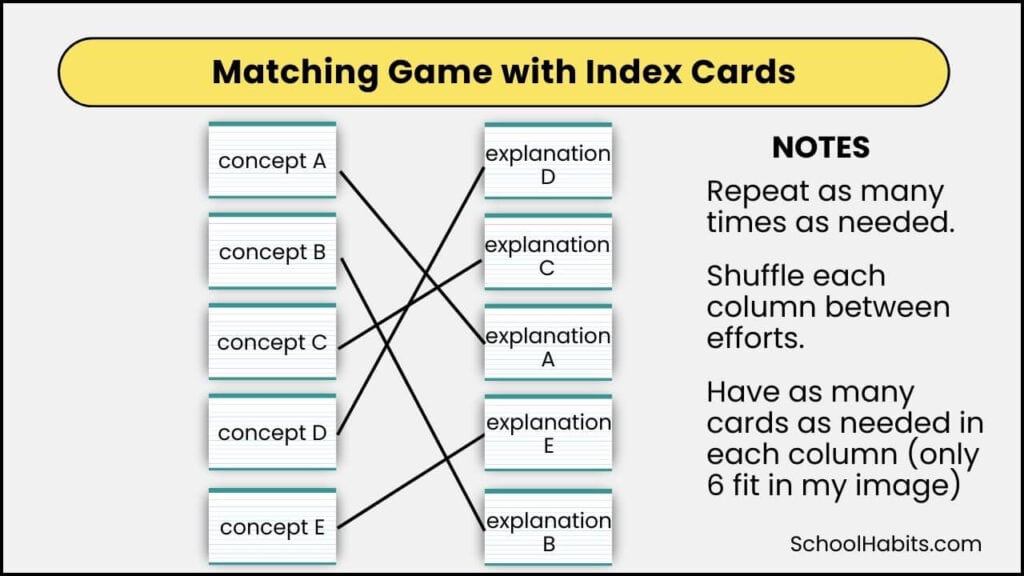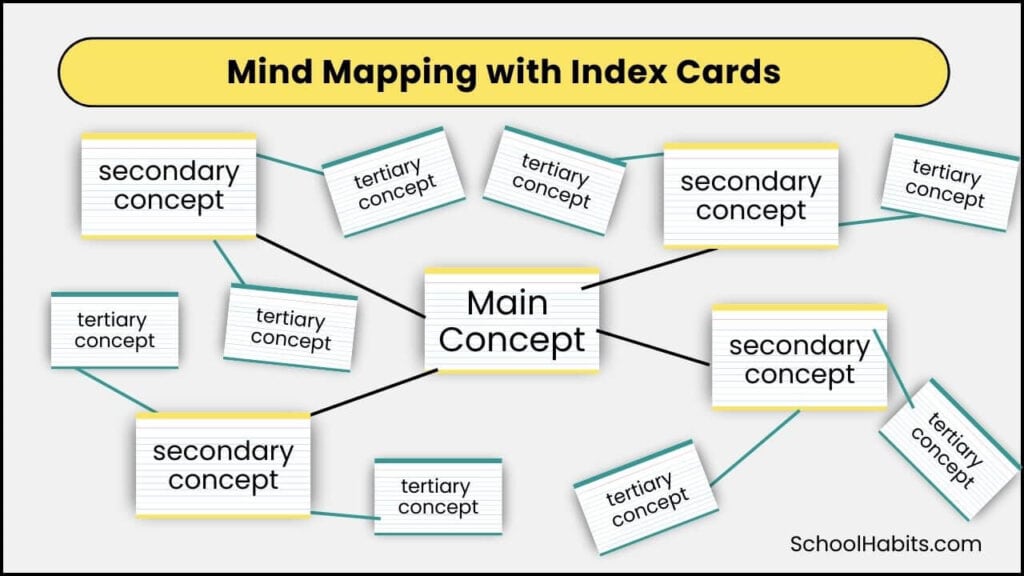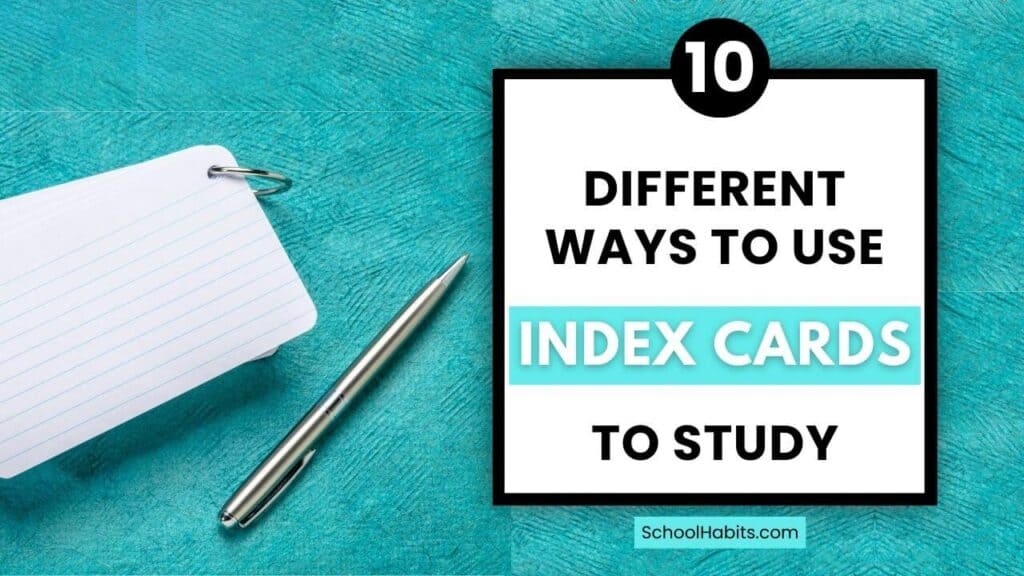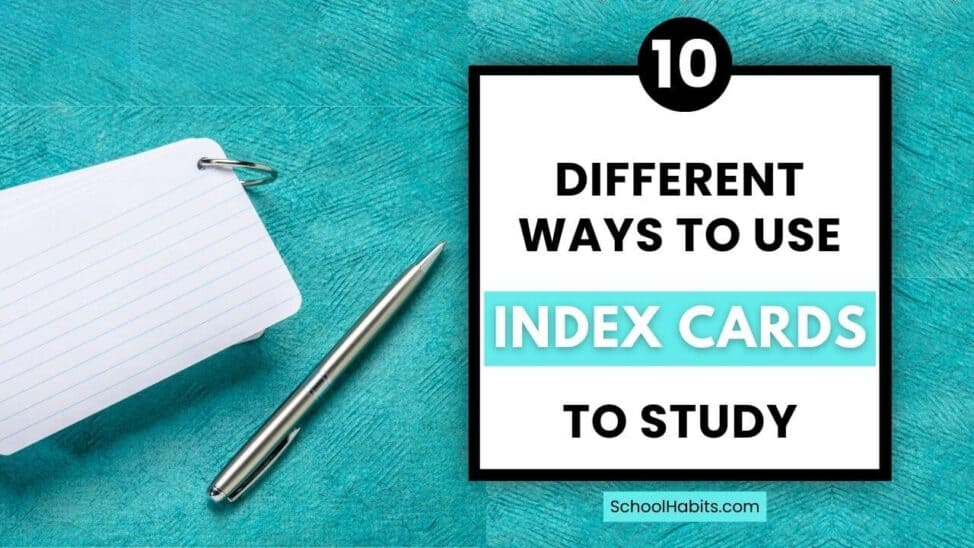By Katie Azevedo, M.Ed.
You can find an endless amount of apps, games and programs that claim to help you study. And while some of these are fun and can be an effective way to do a final review of the material you’re learning, I argue that the simplest tools really are the best.
Cue the index card.
In this blog post, I’m teaching you 10 ways to use index cards to study.
Why are index cards such a great study tool? So many reasons:
- Index cards are relatively inexpensive
- They’re versatile
- They come in various shapes, sizes and colors
- They’re easy to find
- There are so many ways to use them for active recall
10 Different Ways to Use Index Cards to Study
Below is a list of 10 different ways to use index cards to study. You can combine multiple strategies, or use just one, depending on the content you’re learning.
Remember, it’s important to change up your study methods based on how much material you have to learn, what type of material it is, and your current familiarity with it.
Therefore, if you use index cards for any of the study methods below, it is also a good idea to combine them with other study techniques like the Feynman Technique, interleaved practice or even the scaling technique.
1. Make Flashcards and Use the 3 Pile Method
The 3-pile method is the name that I gave to a study strategy involving index cards.
Here’s my full tutorial on how to use the 3-pile method. But real briefly, here’s how it works:
- Make flashcards with the material you’re studying.
- Separate the flashcards into three piles: concepts you know, concepts you don’t know, and concepts you kind of know. (These are the ones that are on the top of your tongue.)
- Start with a pile you kind of know, as this is the material that’s already started to burrow its way into your brain.
- Once you completely know the content from your kind of know pile, move on to the don’t know pile.
- As you make your way through the don’t know pile, gradually make another three piles (know, don’t know, kind of know).
- Repeat steps 2 to 5 until you know all of your material.
2. Make Flashcards and Use the Chunking Method
The Chunking Method is another name I made up in reference to a flashcard study strategy.
The Chunking Method is based on the idea that we better learn, process and retain information when it’s clustered in groups of three or four. Think about it: phone numbers, license plate numbers, Social Security numbers… These are all numbers we’re supposed to commit to memory and they’re all chunked into clusters of three or four.
How does this translate to studying with index cards? When you’re working through a deck of flashcards, break the content into groups of three or four cards and study just one group at a time.
Example: Let’s say that you have 20 flashcards:
- Make five groups of four.
- Study the first group until you know it well.
- Study the second group until you know it well.
- Go back to the first group and make sure you still know all the content
- Return to the second group and make sure you still know the content
- Study the third group until you know it well.
- Continue in this manner (always looping back to the first group) until you make your way through all of the groups and know all of the information.
3. Cover Up Your Answers on a Worksheet or Quiz to Test Yourself
I’m throwing in a really basic index card study method: Use an index card to cover up answers on a previous test, quiz, or handout with questions on it.
Previous tests and quizzes are awesome to study from, but only if you use them for active recall. The way you do this is by covering your answers and testing yourself. (Here’s a step-by-step tutorial for how to make study guides from old quizzes.)
If you don’t know the answers without peeking under the index card, then you have to go back and study that material a little more.
4. Categorize and Group the Words
The study strategy doesn’t work for all content, but it works awesomely for some, especially when studying vocabulary.
Our brains like to group new information with information we already know. This is an expected part of the learning process. It’s quite literally one of the only ways to learn new information.
Because our brains naturally like to group information, you can use index cards to take advantage of this cognitive preference.
How does this work?
- Make flashcards for all of the content you need to know for your quiz or test.
- Spread the index cards out on a large surface in front of you.
- Look at the words you wrote and try to find natural ways to connect them and group them into categories.
You could try grouping all positive words together in one group and all negative words together in another group. Maybe you can group words that have similar meanings or make sense in the same context.
If you’re studying something like anatomy, you could group all the content that has something to do with a certain part of the body… You get the idea.
5. Make Timelines with Index Cards
Another way to use index cards to study is to make timelines. Again, this study method works best for content that’s related to time, obviously. So in most cases, that would be for a history class.
Here’s how it works:
- Write all of the events you need to know on one side of an index card.
- Write the dates of those events on the other side of the index card.
- Flip the cards over so only the events are facing up and you can’t see the dates.
- On a large surface, try to arrange the events chronologically into a timeline. Try to do this without flipping over the cards or looking at your notes.
- Check your work and repeat the process until you have total accuracy.
6. Make a Matching Game to Study with Index Cards
Who doesn’t like a good matching game to bring us back to childhood? This is a study method that you can use by yourself or if you’re studying with someone else.
I assume you know how matching games work, but maybe making a matching game with index cards is new to you.
Here’s how to make a matching game with index cards to study:
- Write all the information you need to know on one side of an index card. Write nothing on the back of the cards.
- On a different set of cards, write all the answers to those questions. This is the information you would normally write on the back of the first group of index cards. But in this case, we’re splitting the questions and answers into two groups.
- Shuffle the pile of index cards with the questions on them and lay them down face up in a vertical column on a flat surface in front of you.
- Next, shuffle the group of index cards with the answers on them and lay those out (answers facing upward) in a second vertical column parallel to the first one. Everything at this point should be in a random order.
- Try to match the questions in the common on the left with the answers in the column on the right.
- Repeat this process as many times as needed by reshuffling the questions, reshuffling the answers, and laying out the columns in a different order.

7. Have Someone Else Test You
This one is simple but also highly effective because, like the other methods, it uses active recall.
You know how this works: Make flashcards with all the concepts you need to know, study them a little bit yourself using one of the other methods, and then give someone else the deck of cards to test you.
I suggest asking the other person to remove from the pile any cards you get right on your first try so that you can focus more on the ones that you don’t yet know. Better yet, integrate the 3-pile method here (Tip #1).
8. Create Mind-Maps with Index Cards
Mind mapping is a great study strategy, and I explain exactly how to do mind maps in the tutorial here. If you’re totally unfamiliar with my mapping, read that tutorial first. After you read that tutorial, or if you’re already familiar with using mind maps to study, keep reading because making my maps with index cards might be something new to you.
How to make a mind map with index cards:
- To make a map with index cards you first need to make a map on paper. Once you have a full mind map on paper, which you can use your notes and resources to make, then you move to index cards.
- With your paper map and a deck of index cars in front of you, write one index card for every concept on your map. You will only use one side of the card. (If you have 30 words on your mind, then you’ll use 30 index cards.)
- Shuffle your index cards.
- Attempt to re-create the map with your index cards on a flat surface in front of you. The goal is to do this without looking at your original map, as that’s what makes it an active recall study strategy. Early on in the study process, you might have to check your paper mind map to fill in the blanks when you’ve gotten as far as you can.
- Repeat this process until you can re-create the entire map without looking at the original.

9. Make a Cheat Sheet
I have a YouTube video and a blog post explaining how to make a cheat sheet for a class. (No, it’s not cheating, and you would never do that because that’s both wrong and dumb.) If you’re unfamiliar with the idea of a cheat sheet, watch the video or read the blog post first.
A cheat sheet is a single reference sheet (usually a piece of paper) that contains all the essential information from a unit. In order to reduce all the information from a unit onto a single sheet of paper, you need to fully understand it. In order to reduce all the information from a unit onto a single index card, you need to REALLY understand it.
10. Make Micro Summaries
If you’re studying information from a textbook or from highly organized notes, you can use index cards to study by creating micro summaries of each topic.
Here’s how this works:
- Starting at the beginning of a textbook chapter, write all main headings and subheadings on index cards. If a chapter has 10 headings with 3 subheadings under each, you would need 30 index cards.
- One at a time, flip over an index card and try to summarize the key points from each heading and subheading. Write this summary on the back of the card.
- Try to complete this activity without looking at your notes. Then, check the textbook to see what you got wrong or missed.
- Repeat until you have total accuracy.
Final Notes About Ways to Study with Index Cards
I said this at the top of the post but it’s worth repeating because it’s important: simple tools are often the best tools, especially when it comes to studying. The good ol’ index card is as simple as it gets, and it’s versatile and inexpensive. Every one of the 10 study methods I listed above uses active recall AND doesn’t have any learning curve (in other words, an index card doesn’t need to come with a user manual). All of these reasons make index cards one of the best study tools out there, and if you’re not using them regularly, you’re missing out and probably overcomplicating your study sessions.


